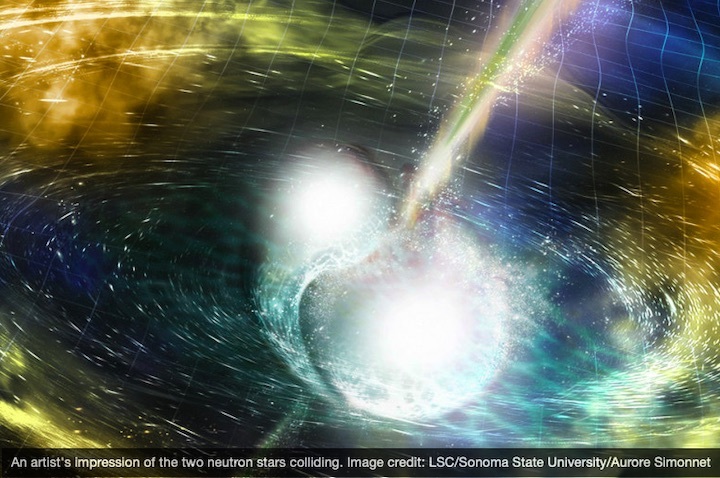5.05.2019

We expect to detect gravitational waves from lots more cataclysmic events - including those we've never detected before such as a black hole swallowing a neutron star and nearby exploding stars, which produce much fainter signals.
An international team of scientists, including from The Australian National University (ANU), have detected two stars colliding in space about 500 million years ago.
The discovery comes just weeks after the restarting of the most sensitive scientific instrument ever built - the Advanced Laser Interferometer Gravitational-wave Observatory (LIGO) - which comprises twin detectors in the United States.
This is the first time such an event has been witnessed since the detectors were taken offline for upgrades to improve their range and precision, and promises a new dawn for space discovery.
On 25 April 2019, one of the LIGO machines detected the ripples in space and time from the collision of two neutron stars, which are the densest stars in the Universe - they have an average radius of 15 kilometres and are twice the mass of our Sun.
The neutron star collision occurred about 4,750 million trillion kilometres away from Earth - a distance which equates to 500 million light years.
ANU plays a lead role in Australia's partnership with LIGO.
Professor Susan Scott, from the ANU Research School of Physics and Engineering, said the achievement was just the beginning, describing the upgraded gravitational-wave detectors as "discovery machines".
"The LIGO gravitational-wave detectors are the most sensitive instruments on Earth," said Professor Scott, Leader of the General Relativity Theory and Data Analysis Group at ANU and a Chief Investigator with the ARC Centre of Excellence for Gravitational Wave Discovery (OzGrav).
"With the improved sensitivity of the detectors during our year of downtime, we have achieved the second detection of two neutron stars smashing into each other - this time in less than one month of observing time.
"We expect to detect gravitational waves from lots more cataclysmic events - including those we've never detected before such as a black hole swallowing a neutron star and nearby exploding stars, which produce much fainter signals."
Dr Terry McRae, from the ANU Research School of Physics and Engineering, said instruments called quantum squeezers, designed at ANU, were installed on the LIGO detectors. This, and other upgrades, have improved the sensing capabilities of the machines. The squeezers dampen quantum noise that can drown out weak gravitational-wave signals.
"With these improvements, the LIGO detectors can see much further into the Universe and detect many more gravitational-wave signals," said Dr McRae who, with ANU graduate student Nutsinee Kijbunchoo, was part of the team that installed and commissioned the squeezers.
Professor Scott said astronomers had to scan a very large area of the sky in search for the latest star collision due to one of the LIGO detectors being offline briefly at the critical moment. The European Gravitational Observatory's gravitational-wave detector in Italy, Virgo, also picked up a signal from the neutron star collision but the signal was very weak.
"ANU led efforts to locate the neutron star collision by scanning a massive region of the southern sky for bright light from the explosion with the SkyMapper telescope," said Professor Scott, who is a co-investigator on the SkyMapper team at ANU.
Dr Chris Onken, from the ANU Research School of Astronomy and Astrophysics, said telescopes like SkyMapper would play a vital role in detecting similar events in the future.
"The hunt goes on," said Dr Onken, who is the SkyMapper Operations Manager.
"With SkyMapper's wide field of view and capability to scan large areas of the southern sky quickly, ANU will play an increasingly important role in the emerging field of gravitational-wave astronomy."
Quelle: The Australian National University




